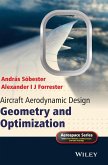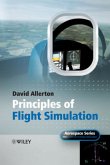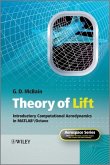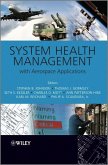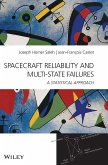Computational Modelling and Simulation of Aircraft and the Environment, Volume 2
Aircraft Dynamics
Herausgeber: Belobaba, Peter; Seabridge, Allan; Cooper, Jonathan
Computational Modelling and Simulation of Aircraft and the Environment, Volume 2
Aircraft Dynamics
Herausgeber: Belobaba, Peter; Seabridge, Allan; Cooper, Jonathan
- Gebundenes Buch
- Merkliste
- Auf die Merkliste
- Bewerten Bewerten
- Teilen
- Produkt teilen
- Produkterinnerung
- Produkterinnerung
This book provides a comprehensive guide to the derivation of computational models from basic physical & mathematical principles, giving the reader sufficient information to be able to represent the basic architecture of air vehicles and their embedded systems. Highly relevant to practitioners, it takes into account the multi-disciplinary nature of aerospace products and the integrated nature of the models needed to represent them. Following on from Volume 1- Platform Kinematics and Synthetic Environment - which focuses on the modelling of the environment in which aircraft operate - this book…mehr
![Aircraft Aerodynamic Design Aircraft Aerodynamic Design]() András SóbesterAircraft Aerodynamic Design129,99 €
András SóbesterAircraft Aerodynamic Design129,99 €![Aircraft Fuel Systems Aircraft Fuel Systems]() Roy LangtonAircraft Fuel Systems159,99 €
Roy LangtonAircraft Fuel Systems159,99 €![Principles of Flight Simulation Principles of Flight Simulation]() David AllertonPrinciples of Flight Simulation179,99 €
David AllertonPrinciples of Flight Simulation179,99 €![Theory of Lift Theory of Lift]() G. D. McBainTheory of Lift134,99 €
G. D. McBainTheory of Lift134,99 €![System Health Management System Health Management]() System Health Management259,99 €
System Health Management259,99 €![Aircraft Systems Integration of Air-Launched Weapons Aircraft Systems Integration of Air-Launched Weapons]() Keith Antony RigbyAircraft Systems Integration of Air-Launched Weapons118,99 €
Keith Antony RigbyAircraft Systems Integration of Air-Launched Weapons118,99 €![Spacecraft Reliability and Multi-State Failures Spacecraft Reliability and Multi-State Failures]() Joseph Homer SalehSpacecraft Reliability and Multi-State Failures173,99 €
Joseph Homer SalehSpacecraft Reliability and Multi-State Failures173,99 €-
-
-
Computational Modelling and Simulation of Aircraft and the Environment represents a development of the existing Aerospace series titles from Moir and Seabridge, as the author draws on some of the same examples used in previous works and dissects them mathematically - thus giving a degree of commonality with earlier books in the series. More high level, detailed mathematics will be allocated to the appendices in order to render the main body of the material digestible as an introductory level text.
* Includes chapters on dynamics and control, flight dynamics & physics, generic aircraft and rotorcraft, vehicle and mission systems, and integration, operability & interoperability
* Serves as both a student text and practitioner reference
* Follows on from previous Aerospace series titles, taking some of the same examples used in these texts and dissecting them mathematically
* Accompanied by a website at www.wiley.com/go/diston which houses software, animations and useful weblinks.
- Produktdetails
- Aerospace Series (PEP)
- Verlag: Wiley & Sons
- 1. Auflage
- Seitenzahl: 208
- Erscheinungstermin: 20. Februar 2024
- Englisch
- Abmessung: 244mm x 170mm x 13mm
- Gewicht: 531g
- ISBN-13: 9780470687116
- ISBN-10: 0470687118
- Artikelnr.: 30590157
- Aerospace Series (PEP)
- Verlag: Wiley & Sons
- 1. Auflage
- Seitenzahl: 208
- Erscheinungstermin: 20. Februar 2024
- Englisch
- Abmessung: 244mm x 170mm x 13mm
- Gewicht: 531g
- ISBN-13: 9780470687116
- ISBN-10: 0470687118
- Artikelnr.: 30590157
Introduction 1 1.1.1 General Introduction to Volume 2 1 1.1.2 What Chapter
1 Includes 1 1.1.3 What Chapter 1 Excludes 2 1.1.4 Overall Aim 2 1.2 Flight
Path 2 1.3 Flight Environment 1.4 Simple Propulsion Model 6 1.4.1 Reference
Parameters 6 1.4.2 Simple Jet Engine Performance 7 1.4.3 'Better' Jet
Engine Performance 8 1.4.4 Simple Jet Engine Dynamics 10 1.5 Simple
Aerodynamic Model 10 1.5.1 Idealised Aircraft 10 1.5.2 Idealised Wing 11
1.5.3 Wing/Tail Combination 13 1.5.4 Lift Distribution 15 1.5.5 Adding
Flight Controls 18 1.6 Airspeed Definitions 20 1.7 Flight Model
Architecture 21 2 Equations of Motion 25 2.1 Introduction 25 2.1.1 The
Problem with Equations of Motion 25 2.1.2 What Chapter 2 Includes 25 2.1.3
What Chapter 2 Excludes 26 2.1.4 Overall Aim 26 2.2 Spatial Reference Model
26 2.2.1 Generic Reference Frames 26 2.2.2 Rotating Reference Frames 28
2.2.3 Elementary Rotations 29 2.2.4 Reference Frames for Position and
Orientation 30 2.2.5 Reference Frame for Flight Path 32 2.2.6 Airspeed and
Airstream Direction 33 2.3 Aircraft Dynamics 34 2.3.1 Mass Properties 34
2.3.2 Flight Parameters 35 2.3.3 Dynamic Equations of Motion 36 2.4
Aircraft Kinematics 39 2.4.1 Aircraft Position 39 2.4.2 Quaternions 40
2.4.3 Kinematic Equations of Motion 41 2.5 Initialisation 42 2.5.1
Balancing Forces 42 2.5.2 Typical Flight Conditions 44 2.5.3 Finding
Aircraft Flight Parameters for Equilibrium 45 2.6 Linearisation 48 2.6.1
Linearisation of Dynamic Equations of Motion 48 2.6.2 Linearisation of
Kinematic Equations of Motion 49 2.6.3 Linearisation of Aerodynamic Forces
and Moments 50 2.6.4 Linearisation of Propulsive Forces and Moments 51
2.6.5 Linearisation of Gravitational Forces and Moments 51 2.6.6 The
Complete Linearised System of Equations 52 3 Fixed-Wing Aerodynamics 55 3.1
Introduction 55 3.1.1 Fixed Wings and Aerodynamics 55 3.1.2 What Chapter 3
Includes 55 3.1.3 What Chapter 3 Excludes 56 3.1.4 Overall Aim 56 3.2
Aerodynamic Principles 56 3.2.1 Aerofoils 56 3.2.2 Dimensional Analysis 58
3.2.3 Lift, Drag, and Pitching Moment 59 3.2.4 Aerodynamic Centre 61 3.2.5
Wing Geometry 63 3.2.6 NACA Four-Digit Sections 64 3.3 Aerodynamic Model of
an Isolated Wing 66 3.3.1 Aerodynamic Lift 66 3.3.2 Pitching Moment 68
3.3.3 Drag Force 69 3.3.4 Profile Drag 69 3.3.5 Induced Drag 70 3.3.6 Wave
Drag 73 3.4 Trailing-Edge Controls 75 3.4.1 Incremental Lift 75 3.4.2
Incremental Drag 78 3.4.3 Incremental Pitching Moment 79 3.4.4 Hinge
Moments 79 3.5 Factors affecting Lift Generation 81 3.5.1 Sideslip 81 3.5.2
Aircraft Rotation 82 3.5.3 Structural Flexibility 83 3.5.4 Ground Effect 85
3.5.5 Indicial Aerodynamics 85 3.6 Lift Distribution 86 3.7 Drag
Distribution 89 4 Longitudinal Flight 91 4.1 Introduction 91 4.1.1 Flight
with Wings Level 91 4.1.2 What Chapter 4 Includes 91 4.1.3 What Chapter 4
Excludes 91 4.1.4 Overall Aim 92 4.2 Aerodynamic Fundamentals 92 4.3
Geometry 92 4.4 Wing/Body Combination 94 4.4.1 Lift Force 94 4.4.2 Downwash
95 4.4.3 Pitching Moment 97 4.4.4 Aerodynamic Centre 99 4.4.5 Drag Force 99
4.5 All-Moving Tail 101 4.5.1 Lift Force 101 4.5.2 Pitching Moment 102
4.5.3 Drag Force 102 4.6 Flight Trim 102 4.7 Flight Stability 103 4.8 Trim
Drag 106 4.8.1 Minimum Drag 106 4.8.2 Relative Speed and Relative Drag 108
4.8.3 Variation of Minimum Drag Speed 110 4.8.4 Minimising 'Minimum' Drag
111 4.9 Steady-State Flight Performance 113 4.9.1 Definitions 113 4.9.2
Airspeeds for Maximum Endurance and Maximum Range 113 4.9.3 Range and
Endurance 114 4.9.4 Alternative Form for Jet Aircraft Range and Endurance
115 4.9.5 Fuel Required to Carry Fuel 116 4.10 Dynamic Modes 117 5 Gas
Turbine Dynamics 123 5.1 Introduction 123 5.1.1 The Importance of Gas
Turbines 123 5.1.2 What Chapter 5 Includes 123 5.1.3 What Chapter 5
Excludes 123 5.1.4 Overall Aim 124 5.2 Ideal Gas Properties 124 5.2.1
Equation of State 124 5.2.2 Energy, Enthalpy, and Entropy 125 5.2.3
Specific Heat Capacity 126 5.2.4 Adiabatic Gas Ratio 126 5.2.5 Compressible
Gas Properties 127 5.2.6 Polytropic Processes 127 5.3 Gas Dynamics 128
5.3.1 Fundamental Relationships for Gas Flow 128 5.3.2 Speed of Sound 129
5.3.3 Bernoulli's Equation 130 5.3.4 Stagnation Conditions 131 5.4 Engine
Components 132 5.4.1 Duct 133 5.4.2 Junction 134 5.4.3 Compressor 134 5.4.4
Split Compressor 136 5.4.5 Combustor 136 5.4.6 Turbine 137 5.4.7 Nozzle 138
5.5 Engine Dynamics 139 5.5.1 Shaft Speed Variation 139 5.5.2 Massflow
Variation 139 5.5.3 Pressure Variation at Constant Temperature 140 5.5.4
Pressure and Temperature Variation 140 5.6 Engine Models 141 5.6.1 Turbojet
Engine 141 5.6.1.1 Turbojet Specification 142 5.6.1.2 Turbojet
Initialisation 144 5.6.1.3 Turbojet Physics 145 5.6.1.4 Turbojet Dynamics
146 5.6.2 Turbofan Engine 147 5.7 Gas Properties Data 150 5.7.1 Summary of
Gas Properties 151 5.7.2 Gas Mixtures defined by Mass Fractions 151 5.7.3
Gas Mixtures defined by Mole Fractions 152 5.7.4 Dry Air 152 5.7.5 Fuel/Air
Combustion Products 153 6 Additional Topics 157 6.1 Introduction 157 6.1.1
Expanding the Scope of Volume 2 157 6.1.2 What Chapter 6 Includes 157 6.1.3
What Chapter 6 Excludes 157 6.1.4 Overall Aim 157 6.2 Structural Models 158
6.2.1 Equations of Motion 158 6.2.2 Coordinate Transformations 159 6.2.3
Coupled Structure 161 6.2.4 Wing-Fuselage Structure 162 6.2.5 Whole
Aircraft Structure 169 6.3 Mass Distribution 170 6.3.1 Mass Properties 170
6.3.2 Transforming Mass Properties 174 6.3.3 Combining Mass Properties 175
6.3.4 Fuel Mass Distribution 175 Bibliography 183 Index 187
Introduction 1 1.1.1 General Introduction to Volume 2 1 1.1.2 What Chapter
1 Includes 1 1.1.3 What Chapter 1 Excludes 2 1.1.4 Overall Aim 2 1.2 Flight
Path 2 1.3 Flight Environment 1.4 Simple Propulsion Model 6 1.4.1 Reference
Parameters 6 1.4.2 Simple Jet Engine Performance 7 1.4.3 'Better' Jet
Engine Performance 8 1.4.4 Simple Jet Engine Dynamics 10 1.5 Simple
Aerodynamic Model 10 1.5.1 Idealised Aircraft 10 1.5.2 Idealised Wing 11
1.5.3 Wing/Tail Combination 13 1.5.4 Lift Distribution 15 1.5.5 Adding
Flight Controls 18 1.6 Airspeed Definitions 20 1.7 Flight Model
Architecture 21 2 Equations of Motion 25 2.1 Introduction 25 2.1.1 The
Problem with Equations of Motion 25 2.1.2 What Chapter 2 Includes 25 2.1.3
What Chapter 2 Excludes 26 2.1.4 Overall Aim 26 2.2 Spatial Reference Model
26 2.2.1 Generic Reference Frames 26 2.2.2 Rotating Reference Frames 28
2.2.3 Elementary Rotations 29 2.2.4 Reference Frames for Position and
Orientation 30 2.2.5 Reference Frame for Flight Path 32 2.2.6 Airspeed and
Airstream Direction 33 2.3 Aircraft Dynamics 34 2.3.1 Mass Properties 34
2.3.2 Flight Parameters 35 2.3.3 Dynamic Equations of Motion 36 2.4
Aircraft Kinematics 39 2.4.1 Aircraft Position 39 2.4.2 Quaternions 40
2.4.3 Kinematic Equations of Motion 41 2.5 Initialisation 42 2.5.1
Balancing Forces 42 2.5.2 Typical Flight Conditions 44 2.5.3 Finding
Aircraft Flight Parameters for Equilibrium 45 2.6 Linearisation 48 2.6.1
Linearisation of Dynamic Equations of Motion 48 2.6.2 Linearisation of
Kinematic Equations of Motion 49 2.6.3 Linearisation of Aerodynamic Forces
and Moments 50 2.6.4 Linearisation of Propulsive Forces and Moments 51
2.6.5 Linearisation of Gravitational Forces and Moments 51 2.6.6 The
Complete Linearised System of Equations 52 3 Fixed-Wing Aerodynamics 55 3.1
Introduction 55 3.1.1 Fixed Wings and Aerodynamics 55 3.1.2 What Chapter 3
Includes 55 3.1.3 What Chapter 3 Excludes 56 3.1.4 Overall Aim 56 3.2
Aerodynamic Principles 56 3.2.1 Aerofoils 56 3.2.2 Dimensional Analysis 58
3.2.3 Lift, Drag, and Pitching Moment 59 3.2.4 Aerodynamic Centre 61 3.2.5
Wing Geometry 63 3.2.6 NACA Four-Digit Sections 64 3.3 Aerodynamic Model of
an Isolated Wing 66 3.3.1 Aerodynamic Lift 66 3.3.2 Pitching Moment 68
3.3.3 Drag Force 69 3.3.4 Profile Drag 69 3.3.5 Induced Drag 70 3.3.6 Wave
Drag 73 3.4 Trailing-Edge Controls 75 3.4.1 Incremental Lift 75 3.4.2
Incremental Drag 78 3.4.3 Incremental Pitching Moment 79 3.4.4 Hinge
Moments 79 3.5 Factors affecting Lift Generation 81 3.5.1 Sideslip 81 3.5.2
Aircraft Rotation 82 3.5.3 Structural Flexibility 83 3.5.4 Ground Effect 85
3.5.5 Indicial Aerodynamics 85 3.6 Lift Distribution 86 3.7 Drag
Distribution 89 4 Longitudinal Flight 91 4.1 Introduction 91 4.1.1 Flight
with Wings Level 91 4.1.2 What Chapter 4 Includes 91 4.1.3 What Chapter 4
Excludes 91 4.1.4 Overall Aim 92 4.2 Aerodynamic Fundamentals 92 4.3
Geometry 92 4.4 Wing/Body Combination 94 4.4.1 Lift Force 94 4.4.2 Downwash
95 4.4.3 Pitching Moment 97 4.4.4 Aerodynamic Centre 99 4.4.5 Drag Force 99
4.5 All-Moving Tail 101 4.5.1 Lift Force 101 4.5.2 Pitching Moment 102
4.5.3 Drag Force 102 4.6 Flight Trim 102 4.7 Flight Stability 103 4.8 Trim
Drag 106 4.8.1 Minimum Drag 106 4.8.2 Relative Speed and Relative Drag 108
4.8.3 Variation of Minimum Drag Speed 110 4.8.4 Minimising 'Minimum' Drag
111 4.9 Steady-State Flight Performance 113 4.9.1 Definitions 113 4.9.2
Airspeeds for Maximum Endurance and Maximum Range 113 4.9.3 Range and
Endurance 114 4.9.4 Alternative Form for Jet Aircraft Range and Endurance
115 4.9.5 Fuel Required to Carry Fuel 116 4.10 Dynamic Modes 117 5 Gas
Turbine Dynamics 123 5.1 Introduction 123 5.1.1 The Importance of Gas
Turbines 123 5.1.2 What Chapter 5 Includes 123 5.1.3 What Chapter 5
Excludes 123 5.1.4 Overall Aim 124 5.2 Ideal Gas Properties 124 5.2.1
Equation of State 124 5.2.2 Energy, Enthalpy, and Entropy 125 5.2.3
Specific Heat Capacity 126 5.2.4 Adiabatic Gas Ratio 126 5.2.5 Compressible
Gas Properties 127 5.2.6 Polytropic Processes 127 5.3 Gas Dynamics 128
5.3.1 Fundamental Relationships for Gas Flow 128 5.3.2 Speed of Sound 129
5.3.3 Bernoulli's Equation 130 5.3.4 Stagnation Conditions 131 5.4 Engine
Components 132 5.4.1 Duct 133 5.4.2 Junction 134 5.4.3 Compressor 134 5.4.4
Split Compressor 136 5.4.5 Combustor 136 5.4.6 Turbine 137 5.4.7 Nozzle 138
5.5 Engine Dynamics 139 5.5.1 Shaft Speed Variation 139 5.5.2 Massflow
Variation 139 5.5.3 Pressure Variation at Constant Temperature 140 5.5.4
Pressure and Temperature Variation 140 5.6 Engine Models 141 5.6.1 Turbojet
Engine 141 5.6.1.1 Turbojet Specification 142 5.6.1.2 Turbojet
Initialisation 144 5.6.1.3 Turbojet Physics 145 5.6.1.4 Turbojet Dynamics
146 5.6.2 Turbofan Engine 147 5.7 Gas Properties Data 150 5.7.1 Summary of
Gas Properties 151 5.7.2 Gas Mixtures defined by Mass Fractions 151 5.7.3
Gas Mixtures defined by Mole Fractions 152 5.7.4 Dry Air 152 5.7.5 Fuel/Air
Combustion Products 153 6 Additional Topics 157 6.1 Introduction 157 6.1.1
Expanding the Scope of Volume 2 157 6.1.2 What Chapter 6 Includes 157 6.1.3
What Chapter 6 Excludes 157 6.1.4 Overall Aim 157 6.2 Structural Models 158
6.2.1 Equations of Motion 158 6.2.2 Coordinate Transformations 159 6.2.3
Coupled Structure 161 6.2.4 Wing-Fuselage Structure 162 6.2.5 Whole
Aircraft Structure 169 6.3 Mass Distribution 170 6.3.1 Mass Properties 170
6.3.2 Transforming Mass Properties 174 6.3.3 Combining Mass Properties 175
6.3.4 Fuel Mass Distribution 175 Bibliography 183 Index 187


